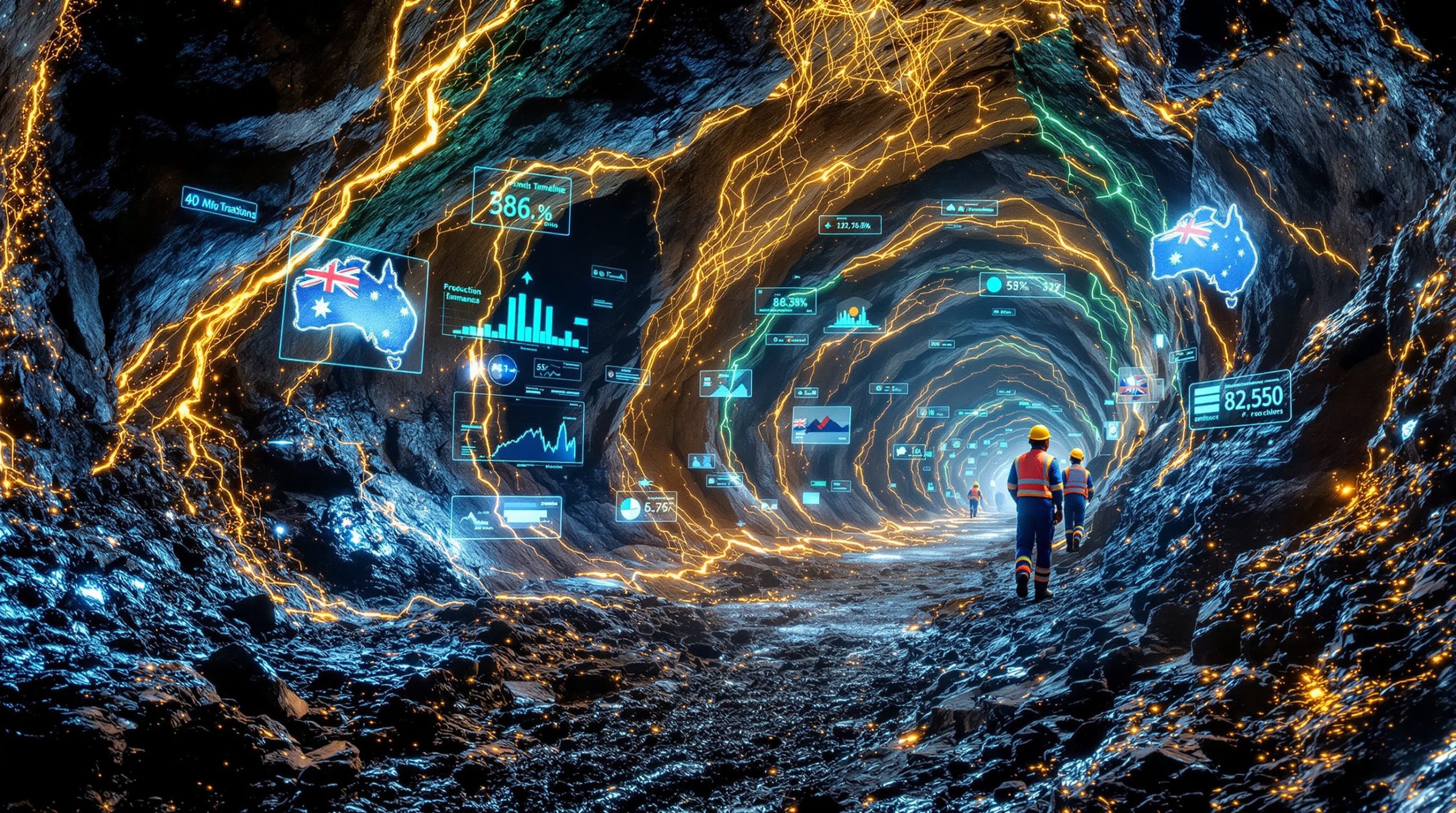The Strategic Imperative Behind Critical Minerals Diplomacy
Global supply chain vulnerabilities exposed during the COVID-19 pandemic fundamentally altered how democratic nations approach strategic resource security. As geopolitical tensions reshape international trade relationships, the traditional model of lowest-cost sourcing has given way to strategic partnerships prioritising reliability, governance alignment, and long-term security over purely economic considerations.
This transformation in strategic thinking underpins the EIB Global Australia critical minerals partnership signed on November 18, 2025. Rather than representing a conventional financing arrangement, this declaration of intent signals a comprehensive approach to energy transition security that extends across the entire value chain from exploration through recycling and innovation.
The partnership framework emerges within a broader context of democratic nations establishing alternative supply chains to reduce dependencies on concentrated authoritarian suppliers. Analysis of current global critical minerals markets reveals significant concentration risks, with certain materials dominated by single-country suppliers whose geopolitical alignment may not match Western strategic interests.
Strategic Foundations of the EIB Global Australia Critical Minerals Alliance
European Supply Chain Diversification Requirements
The EU Critical Raw Materials Act, enacted in March 2024, establishes mandatory diversification targets requiring 65% of critical minerals supply from non-concentrated sources by 2030. This legislation represents Europe's most comprehensive strategic autonomy initiative in resource security, fundamentally altering investment criteria for development finance institutions like EIB Global.
Strategic autonomy goals now drive institutional investment decisions beyond traditional risk-return models. The Act specifically prioritises partnerships with democratic governance frameworks, regulatory transparency, and ESG alignment – criteria that position Australia as an optimal strategic partner compared to alternative supplier nations.
Analysis of major suppliers reveals Australia's competitive advantages:
- Governance Framework: Democratic institutions with transparent regulatory processes
- Resource Base: Comprehensive critical minerals reserves across multiple commodity categories
- Processing Capability: Existing infrastructure for value-addition beyond raw material exports
- Strategic Alignment: NATO partnership and Five Eyes intelligence cooperation
Australia's Critical Minerals Market Position
Australia maintains world-leading reserves across multiple critical minerals categories essential for renewable energy transition and defence applications. Current production data demonstrates substantial global market influence:
| Mineral | Global Ranking | Reserve Estimate | 2024 Production | Market Share |
|---|---|---|---|---|
| Lithium | #1 (reserves) | 8.7 million tonnes | 86,000 tonnes | 47% |
| Rare Earths | #2 (reserves) | 4.2 million tonnes REO | 22,000 tonnes | 8% |
| Cobalt | #3 (production) | 1.4 million tonnes | 5,200 tonnes | 4% |
| Nickel | #4 (reserves) | 21 million tonnes | 160,000 tonnes | 6% |
Lithium production capacity represents Australia's most significant strategic advantage, with 47% global market share supporting European battery manufacturing supply chains. Processing capabilities currently focus on spodumene concentrate exports, creating substantial value-addition opportunities through direct lithium extraction and battery-grade processing facilities.
Furthermore, the development of lithium industry innovations continues to strengthen Australia's position. Rare earth processing presents strategic opportunities for European supply chain integration. While China dominates global rare earth separation and refining, Australia's Mount Weld and other deposits provide feedstock for potential European processing facilities, reducing dependence on Chinese value-added products.
Investment Framework Innovation Beyond Traditional Mining Finance
Comprehensive Strategic Partnership Architecture
EIB Global's investment approach transcends conventional debt financing through direct equity participation mechanisms in Australian mining ventures. This structure provides patient capital for long-term development while ensuring strategic alignment between European demand and Australian supply capacity.
Technology transfer programmes represent a key differentiation factor, linking European innovation in processing, environmental management, and automation with Australian mining operations. These partnerships create competitive advantages through:
- Battery Chemistry Innovation: European battery manufacturers sharing specifications for optimal raw material processing
- Environmental Technology: Advanced water treatment and emissions reduction systems
- Automation Systems: Robotics and AI applications for mining efficiency improvements
- Recycling Integration: Circular economy technologies for end-of-life battery processing
Long-term offtake agreements provide revenue certainty enabling accelerated project development timelines. Industry analysis indicates qualifying operations benefit from 12-24 month development acceleration compared to traditional financing arrangements, while preferential European offtake agreements improve project financing terms through guaranteed revenue streams.
Risk Assessment Evolution in Geopolitical Context
Traditional mining project evaluation focused primarily on geological risk, permitting timelines, and market pricing volatility. The EIB Global framework integrates supply chain security metrics into project evaluation, weighing strategic importance alongside commercial viability assessments.
Government backing mechanisms reduce regulatory and permitting risks through bilateral cooperation frameworks. The partnership provides fast-track approval processes for qualifying projects, while infrastructure development commitments support processing facility construction and export logistics.
Strategic Investment Impact: Operations qualifying for EIB Global support gain access to streamlined permitting reducing development timelines by 12-24 months, while preferential European offtake agreements provide revenue certainty improving project financing terms and enabling lower-cost capital access.
Value-Addition Opportunities Through Processing Integration
Economic Transformation Beyond Raw Material Exports
Battery-grade lithium processing delivers 200-300% higher returns than spodumene concentrate exports, creating substantial value-addition opportunities within Australia. Current lithium processing focuses on basic concentration, leaving advanced chemical conversion to Chinese facilities.
Direct lithium extraction (DLE) technology enables on-site processing of lithium brine and hard rock resources into battery-grade lithium carbonate or hydroxide. European chemical companies possess advanced DLE technologies suitable for technology transfer to Australian operations, creating integrated supply chains bypassing Chinese processing capacity.
Moreover, recent developments in battery recycling breakthrough technologies highlight the importance of circular economy integration. Rare earth separation facilities represent strategic opportunities for European supply chain integration. Current Australian rare earth production exports mixed concentrates to China for separation into individual elements. European investment in Australian separation facilities would create supply chain security for critical defence and renewable energy applications.
Industrial Ecosystem Development
Research and development capability expansion creates multiplier effects beyond mining operations. Joint European-Australian research facilities focus on:
- Advanced Materials Development: Next-generation battery chemistries requiring specialised mineral specifications
- Processing Innovation: Environmentally sustainable extraction and refining technologies
- Circular Economy Integration: End-of-life product recycling for critical minerals recovery
- Defence Applications: Specialised materials for military and aerospace applications
In addition to these developments, Australia's green metals leadership position strengthens through strategic partnerships. Technology sector spillover benefits emerge through mining automation, environmental monitoring, and processing innovation. Australian technology companies gain access to European markets while European firms establish Asia-Pacific operations through Australian joint ventures.
International Precedents Shaping Partnership Framework
US-Australia Strategic Cooperation Model
The US-Australia $3 billion commitment announced in 2023 provides a precedent for large-scale democratic alliance cooperation in critical minerals. This arrangement includes price floor mechanisms ensuring minimum pricing for Australian producers during market downturns, while offtake rights guarantee US access to Australian production.
According to Reuters analysis, the EIB Global partnership follows similar principles while incorporating European-specific requirements. Bilateral resource partnership models create contractual demand certainty enabling long-term investment planning. The US arrangement demonstrates how strategic allies can utilise government backing to compete with state-subsidised competitors while maintaining market-based pricing mechanisms.
Strategic alignment benefits extend beyond commercial arrangements to include defence cooperation, technology sharing, and joint research initiatives. These comprehensive partnerships create economic interdependence supporting broader geopolitical alliance structures.
G7 Critical Minerals Production Alliance
Canada-led initiatives mobilise public-private capital for graphite, rare earths, and scandium development across G7 nations. The Partnership for Global Infrastructure and Investment specifically targets critical minerals as strategic priorities requiring coordinated democratic response.
Rio Tinto and Nouveau Monde Graphite offtake agreements serve as partnership templates demonstrating how major mining companies integrate with smaller specialised producers through long-term contracts and equity participation.
Coalition building for supply chain resilience creates competitive alternatives to Chinese-dominated supply chains. G7 coordination ensures democratic suppliers receive preferential access to Western markets while maintaining competitive pricing through inter-alliance competition.
Partnership Significance: The EIB Global Australia partnership represents Europe's first formal institutional investment framework for Australian critical minerals, combining direct equity participation, technology transfer, and long-term offtake agreements to reduce dependence on concentrated Asian supply chains while supporting strategic autonomy objectives.
Market Impact Scenarios and Supply Chain Transformation
Supply Chain Resilience Modelling 2025-2030
Scenario modelling projects 30% reduction in Chinese supply dependency by 2030 through enhanced EU-Australia cooperation. This diversification requires substantial investment in Australian processing capacity complementing existing mining operations.
Alternative supply pathway development creates redundancy for critical European industries including automotive, defence, and renewable energy sectors. Buffer inventory creation and strategic stockpiling provide additional security during supply disruptions.
However, the broader mining industry evolution continues to reshape operational approaches. Processing capacity requirements necessitate significant capital investment in Australian facilities. European technology transfer accelerates development timelines while ensuring compatibility with European manufacturing specifications.
Competitive Response Patterns
Chinese supply chain consolidation responses include vertical integration of mining, processing, and manufacturing operations. State-backed Chinese companies may increase acquisition attempts of Australian mining assets, requiring foreign investment screening coordination between Australia and European partners.
Indonesian nickel and rare earth processing expansion represents competitive response to Australian-European partnerships. Indonesia's resource nationalism policies create opportunities for Australian producers while potentially restricting Indonesian supply to non-aligned nations.
Furthermore, as highlighted in Mining Technology reports, Technology transfer restrictions and export control implications affect equipment and knowledge sharing. US, European, and Australian coordination on critical technology exports ensures allied advantages while preventing technology leakage to strategic competitors.
Australian Mining Companies Positioned for EIB Global Support
Major ASX-Listed Critical Minerals Producers
BHP Group (ASX: BHP) operates substantial nickel mining operations in Western Australia while expanding battery materials exposure through the Nickel West division. Processing capacity expansion projects align with European battery manufacturing requirements, making BHP a priority candidate for EIB Global investment.
Rio Tinto (ASX: RIO) develops lithium projects including the Rincon project in Argentina and Jadar project in Serbia. European operations and existing European customer relationships position Rio Tinto for integrated supply chain development with EIB Global support.
Mineral Resources (ASX: MIN) operates Australia's largest lithium processing facility at Kemerton in Western Australia. Downstream integration plans include battery-grade lithium production suitable for direct European supply, representing optimal alignment with EIB Global investment criteria.
South32 (ASX: S32) focuses on manganese production essential for steel and battery manufacturing. Australian manganese operations provide strategic alternatives to South African supply while supporting European steel and battery industries.
Emerging Critical Minerals Developers
Project development acceleration through EIB Global financing access enables mid-tier companies to advance projects faster than traditional financing arrangements. Streamlined permitting and guaranteed offtake agreements reduce development risks enabling lower-cost capital access.
European market integration opportunities provide emerging producers with direct access to end-user customers rather than spot market exposure. Long-term contract pricing reduces commodity price volatility while ensuring supply security for European manufacturers.
Technology partnership potential enables smaller producers to access European processing innovation and environmental technologies typically available only to major mining companies. Joint venture structures facilitate knowledge transfer while maintaining Australian operational control.
Regulatory Framework Enabling Strategic Partnership Success
EU Critical Raw Materials Act Implementation
Strategic project designation criteria establish fast-track approval processes for projects meeting strategic importance thresholds. Projects qualifying under these criteria gain access to streamlined environmental assessment, permitting acceleration, and preferential financing terms.
Public-private partnership mechanisms enable risk sharing between government agencies and private investors. European guarantees reduce political and regulatory risks for Australian investments while Australian government support addresses permitting and infrastructure requirements.
Diversification mandate compliance requires European companies to demonstrate supply chain diversification meeting Act requirements. Australian suppliers gain preferential status in European procurement decisions, creating competitive advantages over non-aligned suppliers.
Australian Government Support Framework
Export facilitation and regulatory streamlining reduce administrative barriers for qualifying critical minerals projects. The Modern Manufacturing Strategy specifically identifies critical minerals processing as national priority receiving accelerated regulatory treatment.
Infrastructure development commitments support processing facility construction through co-investment in power, transport, and water infrastructure. Government backing reduces capital requirements for private investors while ensuring project viability.
Bilateral trade agreement enhancements remove tariff and non-tariff barriers to critical minerals trade between Australia and the EU. Mutual recognition of standards and certifications reduces compliance costs while maintaining quality assurance.
Market Dynamics and Pricing Evolution
Price Discovery Mechanism Transformation
Long-term contract pricing versus spot market volatility creates more stable revenue streams for producers while providing supply certainty for European manufacturers. Contract structures typically include floor pricing preventing below-cost sales during market downturns.
European demand certainty creates price floor effects supporting higher investment levels in Australian operations. Guaranteed European offtake reduces merchant market exposure while maintaining competitive pricing through inter-supplier competition.
Supply chain premium valuation for democratic suppliers reflects strategic value beyond commodity pricing. European companies may pay premium pricing for supply chain security, creating competitive advantages for Australian producers aligned with strategic partnerships.
Investment Flow Redirection Analysis
Capital allocation shifts toward allied nation suppliers represent fundamental changes in investment decision-making. ESG-focused investors increasingly prioritise governance and strategic alignment alongside financial returns, benefiting Australian operations.
Technology development funding for processing innovation flows through partnership arrangements rather than standalone R&D investment. Joint European-Australian development programmes leverage combined expertise while sharing development costs and market risks.
Strategic mineral stockpiling investment requirements create additional demand beyond manufacturing consumption. Government and private sector strategic reserves provide market support during demand fluctuations while ensuring supply security during geopolitical tensions.
What are the key benefits of the EIB Global Australia critical minerals partnership?
The partnership provides multiple advantages including accelerated project development timelines, reduced financing costs, technology transfer opportunities, and preferential access to European markets through guaranteed offtake agreements.
When will EIB Global financing commence for Australian projects?
Initial project financing is targeted for Q2 2026 following detailed investment criteria development and project pipeline assessment. The November 2025 declaration establishes the framework requiring operational implementation over subsequent months.
What project types qualify for EIB Global support?
Projects spanning the complete critical minerals value chain qualify, including exploration, extraction, processing, recycling, and innovation initiatives. Emphasis focuses on strategic importance to European supply chain security and alignment with EU Critical Raw Materials Act objectives.
How does this partnership impact existing Australian mining operations?
Current operations gain access to European capital, technology transfer opportunities, and preferential offtake agreements. New projects benefit from accelerated development timelines, reduced financing costs, and streamlined regulatory approval processes.
Long-Term Strategic Transformation and Success Metrics
Measuring Partnership Effectiveness
Supply chain diversification percentage targets by 2030 provide measurable success criteria for the partnership's strategic objectives. European tracking systems monitor import source diversification ensuring compliance with Critical Raw Materials Act mandates.
Processing capacity development in Australia versus European facilities balances supply chain security with economic optimisation. Joint investment in Australian processing creates secure supply while maintaining cost competitiveness compared to Asian alternatives.
Consequently, the EIB Global Australia critical minerals partnership establishes a framework for measuring technology transfer success rates through innovation spillover effects and competitive advantage development. Joint patents, licensing agreements, and commercial deployment metrics demonstrate partnership value beyond financial returns.
Geopolitical Resilience Through Economic Integration
Democratic alliance strengthening through economic integration creates interdependence supporting broader strategic cooperation. Resource security partnerships reinforce defence cooperation and intelligence sharing arrangements among allied nations.
Supply chain security enhancement reduces authoritarian leverage over critical Western industries. Alternative supply sources provide negotiating power during geopolitical tensions while maintaining competitive market dynamics.
Strategic mineral access guarantees support defence and technology sector requirements during crisis periods. Government-to-government agreements ensure priority access for critical applications while maintaining commercial market operations for standard industrial uses.
Strategic Partnership Transformation: The EIB Global Australia critical minerals partnership represents a fundamental evolution from transaction-based mining finance toward comprehensive strategic cooperation integrating supply chain security, technology advancement, and democratic alliance building through economic interdependence.
The partnership's success depends on balancing commercial viability with strategic objectives while maintaining competitive market dynamics. Long-term effectiveness requires sustained political commitment from both European and Australian governments alongside private sector engagement throughout changing market conditions.
Investment implications extend beyond individual mining projects to encompass industrial ecosystem development, technology innovation, and geopolitical alliance strengthening. The framework establishes precedents for democratic cooperation in strategic resource security that may extend to other critical materials and allied nation partnerships.
Disclaimer: This analysis contains forward-looking assessments based on current partnership declarations and policy frameworks. Actual investment flows, project development timelines, and strategic outcomes may vary based on market conditions, regulatory changes, and geopolitical developments. Readers should conduct independent research before making investment decisions related to critical minerals markets or specific mining companies mentioned in this analysis.
Looking to Capitalise on Australia's Critical Minerals Boom?
Discovery Alert's proprietary Discovery IQ model delivers instant notifications on significant ASX mineral discoveries, empowering investors to identify actionable opportunities in critical minerals companies ahead of the broader market. With major partnerships like the EIB Global agreement driving unprecedented investment into Australian critical minerals projects, explore Discovery Alert's discoveries page to understand why historic discoveries can generate substantial returns and begin your 30-day free trial today.




